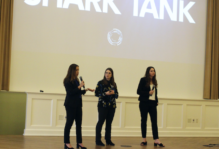Civil Rights Leader Honored at Active Citizens Conference
Guest blogger Alexander Nocks’ reflection on the impact of Barbara Johns, civic rights leader, as described at the 2018 Active Citizens Conference.
The Active Citizenship Conference’s keynote speaker told the story of Moton High School. I had never heard of Moton, but I definitely knew the story. In fact I had seen it in the same room four days earlier. As Justin G. Reid spoke Saturday, I could not help but remember Backpacks Full of Cash which had played on the screen above his head earlier in the week. The film, a response to the pro-charter school Waiting for Superman, depicted the inequality of urban schools being exacerbated by resource-concentrating charter schools. Hearing the description of the segregated Moton high school match the schools depicted in the film nearly detail-for-detail was troubling and shocking. I knew that education is still very segregated and unequitable, but I had underestimated the extent of similarities between the 1950’s and today.
The most disheartening similarity is not the material hardships, but rather the justification for the inequity. Reid described the prevailing philosophy on education for Moton students as
“just needing enough education to be maids.” Those in power simply assumed that Moton students were not interested in the key to social mobility. They projected an unwarranted level of complacency onto the students in assuming that they were content to fill the roles expected of them. They wrote off the students’ potential, ambition, and individual agency. In doing so, Moton high school students were put at a significant disadvantage, by people who felt completely justified in doing so. This dehumanizing paternalism entrenched the stacked deck against these students under the false premise that they were not even interested in the opportunities afforded to others. The institutionalized barriers to success arose not only in the community’s outlook on the school and its students, but in the material realities of those who attended Moton.
While Moton made do with cut-rate leftovers, three blocks away, its all white counterpart, Farmville High School, had everything anyone could possibly want. Reid described it as a “three story, castle-like” marvel. Even in the 1950s, it had a gym, lockers, a swimming pool, and other high end features. Moton High School had none of those, nor even a cafeteria.
Built to hold 180 students, by the 1950 school year, it hosted around 500 students — nearly three times its capacity. To accommodate all the students, all of whom Moton was required to accept, three tar paper shacks were erected around the school. Even still, classrooms were overflowing with students. The roofs leaked and the only heat source was a potbelly stove. All Moton’s uniforms, books, buses, and related resources were hand-me-downs for which Farmville High School no longer had any use. Were it not for the brilliant leadership of Barbara Johns and her committee, it likely would have stayed that way, because those with the capacity to change the situation thought it was good enough for those type of students.
It was saddening to realize how recent the situation Reid was describing occurred — my grandparents were the same age as those who attended that version of Moton High School. Even more alarming is the realization of how many schools with the same inequality people of my children’s’ generation will attend. Granted, there is a meaningful difference between de jure segregation and today’s defacto segregation and resource disparity, and the achievements of Barbara Johns and her colleague should not be overlooked. Nonetheless, it is disappointing that aside from legal segregation, Reid’s description of 1950 Moton High School could seamlessly be applied to so many schools and school systems today.
Reid notes that the resource disparity in Prince Edward County was not treated as a problem, because Moton students “didn’t need state of the art facilities.” And yet charter schools boast motion-capture studios and a glutinous variety of underutilized technology while their poorer counterparts struggle to keep basic facilities operational. Is society really better off with that resource distribution model? But that is not the question being asked. Instead, society looks at students in the underfunded, overcrowded schools and decides that they have all they need to be all that they can be. I cannot help but wonder what it would take to help people recognize that those students can be everything if only we would be willing to give them anything.
While laws do not directly prevent families from transferring schools, discrimination-driven economic realities do. For many, voting with their feet and picking a top-notch school is not possible. I went to an outstanding public high school — one of the best in the country. But the vast majority of properties in my hometown were expensive and rarely for sale. Taxes are exceptionally high on all of them. When I was a little older than one, my parents moved from the Philadelphia suburbs to my current home. After reviewing school districts from around the country, they settled on Wyoming, Ohio — an education-at-all costs community. My mother’s parents, who also live there, housed us for nine months until our home was ready. That privilege to pay the costs of choosing is so rare. For many who face even worse educational prospects than I would have had outside of Philadelphia, any move of that sort is out of the picture. They are stuck in under-supported schools and left to fight uphill for their future almost entirely alone. Their potential written off, these students are expected to fail, so no one invests in them. What would it take to inspire and support leadership like Barbara John’s for these students and how many futures will be crippled before then?




No comments.
Comments are currently closed. Comments are closed on all posts older than one year, and for those in our archive.